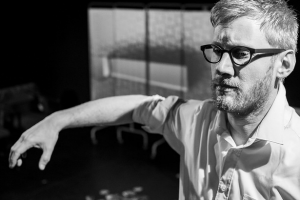
A Fortunate Man is Michael Pinchbeck’s eponymous interpretation of the book by philosopher, critic and novelist John Berger and photographer Jean Mohr. The book is still widely acclaimed by ageing GPs to be the apogee of general practice literature.
Very close to the book’s end, Berger speculates about Sassall’s death. ‘And supposing he were dead? You might ask. But if he were dead I would write a different essay.’
It was around 10 years after I first read A Fortunate Man that I learned about Sassall’s death by suicide. Unlike the book, Pinchbeck begins with the fact of his death. It is therefore a play about a book about a doctor who killed himself.
Pinchbeck’s stage version is presented as a lecture with Matthew Brown as Sassall and Hayley Doherty as Betty, Sassall’s wife. The play skilfully immerses the audience in both Berger’s text and the original black and white photographs by Jean Mohr, which are projected onto an old fashioned medical screen.
We need to be less isolated and more aware of our own vulnerability and inner wounded healer
Within the first five minutes of the performance the audience are brilliantly situated in the landscape at the beginning of the book. Memorable scenes, such as when Sassall attends to a man whose leg is trapped under a tree, are acted against this backdrop taking anyone familiar with the book straight back into its pages.
There are more contemporary images as well. A colour photograph of a sink full of dirty coffee cups against a soundtrack of a bustling modern surgery captures the hectic, caffeine-fuelled bustle of a modern surgery. Contemporary interviews, most notably with Sassall’s son, are quoted to give insight into his character and his death.
Sassall was severely depressed and had known a close friend and fellow GP who killed himself a few years before the book was written. He was happiest in a previous role as a ship’s surgeon when dealing with accidental trauma and patients that could be cured, rather than working with the legacy of emotional trauma and patients who could not. ‘He cured others to cure himself,’ Berger wrote – and when he could not cure them, he suffered from an overwhelming sense of failure. This shared experience of shame is captured in the play by his repeated, empathic refrain with his patients, ‘I know, I know, I know’.
We know from the book, but not the play, that Sassall was obsessed with Conrad as a boy, and it is to the heart of darkness that we should look, and not just to the fading idealism of a vocation for which the book is often praised. A Fortunate Man, the book and the production, is a portrait of a wounded healer. It is about the dangers of believing ourselves to be somehow immune to the despair that accompanies trauma because of our social privilege. In an age where psychoanalysis is disparaged, reflection is feared, and professional isolation is still a problem, it is more relevant than ever.
This performance gives us the privilege of hindsight, allowing us to see the despair creeping into Sassall’s life, that concluded with the death of his wife and his suicide shortly afterwards. If we are to be more fortunate men and women than Sassall, we need to be less isolated and more aware of our own vulnerability and inner wounded healer. And this way the legacy of A Fortunate Man might be GPs who combine Sassall’s passion and compassion with resilience and joy.
Dr Jonathon Tomlinson reviewed A Fortunate Man at the Camden People’s Theatre in London.
The play, a production from New Perspectives Theatre, is now touring to The Pound Arts Centre in Corsham, Wiltshire, followed by Blackfriars Theatre and Arts Centre, Boston, then Manchester University Hospitals NHS Foundation Trust (Main Lecture Theatre) before ending with a run at the Edinburgh Festival Fringe.
Image by Julian Hughes
Pulse October survey
Take our July 2025 survey to potentially win £1.000 worth of tokens












